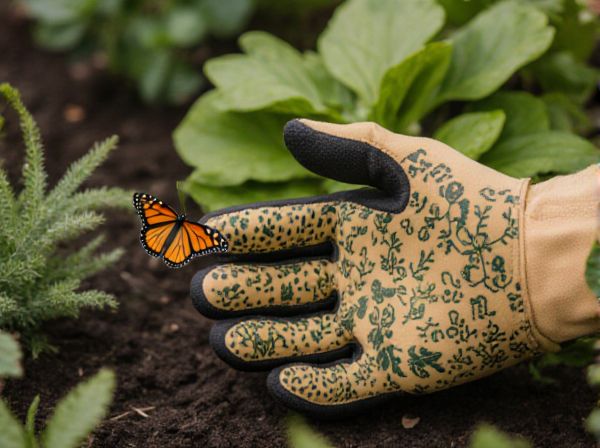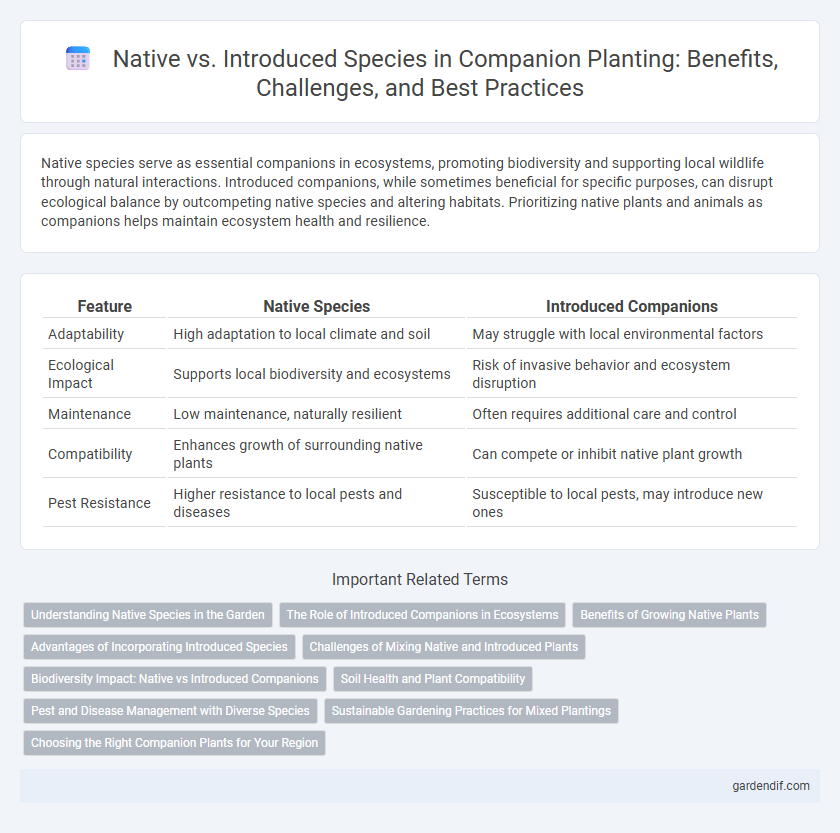
Native species vs introduced companions Illustration
Native species serve as essential companions in ecosystems, promoting biodiversity and supporting local wildlife through natural interactions. Introduced companions, while sometimes beneficial for specific purposes, can disrupt ecological balance by outcompeting native species and altering habitats. Prioritizing native plants and animals as companions helps maintain ecosystem health and resilience.
Table of Comparison
| Feature | Native Species | Introduced Companions |
|---|---|---|
| Adaptability | High adaptation to local climate and soil | May struggle with local environmental factors |
| Ecological Impact | Supports local biodiversity and ecosystems | Risk of invasive behavior and ecosystem disruption |
| Maintenance | Low maintenance, naturally resilient | Often requires additional care and control |
| Compatibility | Enhances growth of surrounding native plants | Can compete or inhibit native plant growth |
| Pest Resistance | Higher resistance to local pests and diseases | Susceptible to local pests, may introduce new ones |
Understanding Native Species in the Garden
Native species play a crucial role in maintaining the ecological balance of gardens, supporting local wildlife such as pollinators and birds. These plants are adapted to the regional climate, soil, and pests, resulting in lower maintenance and increased resilience compared to introduced companions. Understanding native species helps gardeners create sustainable environments that promote biodiversity and long-term garden health.
The Role of Introduced Companions in Ecosystems
Introduced companions can significantly alter ecosystems by competing with native species for resources, sometimes leading to declines in indigenous populations. These species may also introduce new diseases or disrupt existing food webs, affecting biodiversity and ecosystem stability. Managing introduced companions requires understanding their ecological impacts to balance benefits against potential threats to native habitats.
Benefits of Growing Native Plants
Native plants support local ecosystems by providing essential habitat and food sources for native pollinators and wildlife, enhancing biodiversity. They require less water, fertilizers, and pesticides compared to introduced companions, reducing environmental impact and maintenance costs. Native species also improve soil health through deep root systems that prevent erosion and promote nutrient cycling.
Advantages of Incorporating Introduced Species
Incorporating introduced species as companions can enhance biodiversity by filling ecological niches left vacant by native species and improving genetic diversity within local populations. Introduced companions often bring unique ecosystem services such as pest control, soil enrichment, and pollination that native species may lack or underperform. These species can also increase resilience against environmental changes and contribute to sustainable agriculture and horticulture practices by diversifying available resources.
Challenges of Mixing Native and Introduced Plants
Mixing native and introduced companion plants often leads to challenges such as competition for resources, which can result in the decline of native species due to aggressive growth habits of some introduced plants. Introduced companions may also disrupt local ecosystems by altering soil composition, nutrient cycles, and attracting non-native pests or diseases. Managing these interactions requires careful selection and monitoring to maintain biodiversity and ecological balance in companion planting.
Biodiversity Impact: Native vs Introduced Companions
Native companions play a crucial role in maintaining ecosystem stability and supporting local biodiversity, as they have co-evolved with other species in their habitat. Introduced companions can disrupt these systems by outcompeting native species, altering food webs, and spreading diseases. The biodiversity impact of native versus introduced companions directly influences ecosystem resilience and the survival of both flora and fauna.
Soil Health and Plant Compatibility
Native species as companions enhance soil health by supporting local microbial communities and promoting nutrient cycling adapted to the region's ecosystem. Introduced companions may disrupt soil balance and risk incompatibility with native plants, potentially leading to reduced growth or increased susceptibility to pests. Selecting native companions ensures better plant compatibility, fostering resilient and sustainable garden ecosystems.
Pest and Disease Management with Diverse Species
Native species companions contribute to pest and disease management by supporting local ecosystems and promoting natural predator-prey relationships. Introduced companions can sometimes disrupt these balances, increasing vulnerability to pests and diseases; however, carefully selected diverse species combinations enhance resilience. Integrating a variety of native and introduced companions creates a dynamic environment that suppresses pests and reduces disease outbreaks through competitive exclusion and improved biodiversity.
Sustainable Gardening Practices for Mixed Plantings
Native species in sustainable gardening support local ecosystems by providing essential habitats and promoting biodiversity, ensuring resilience against pests and diseases. Introduced companion plants can complement native species by enhancing soil health and attracting beneficial insects, but careful selection is crucial to avoid invasive tendencies. Integrating native and non-invasive introduced companions in mixed plantings optimizes ecosystem services and supports long-term garden sustainability.
Choosing the Right Companion Plants for Your Region
Selecting companion plants native to your region promotes biodiversity, improves soil health, and supports local wildlife, ensuring a balanced ecosystem in your garden. Introduced companion plants may offer aesthetic or pest control benefits but carry risks of invasiveness and ecological disruption if not carefully managed. Assessing local climate, soil conditions, and native plant interactions helps determine the most effective and sustainable companion plants for your specific environment.
Native species vs introduced companions Infographic

 gardendif.com
gardendif.com